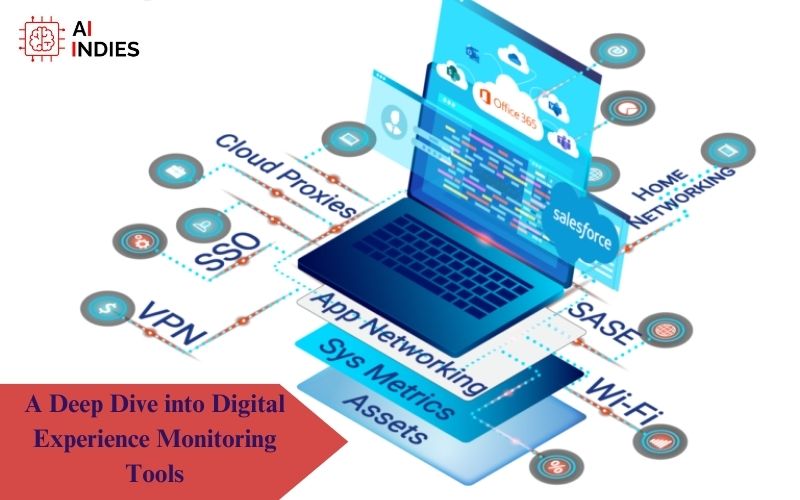In todays fast-paced digital landscape, ensuring a seamless online experience for users is more
critical than ever. Businesses and organizations are constantly striving to enhance their digital
presence, but without the right tools, achieving and maintaining optimal performance can be a
daunting task.This is where Digital Experience Monitoring (DEM) tools come into play. These
tools are designed to provide insights into the performance and user experience of digital
assets such as websites, applications, and other online platforms. In this guide, we will explore the
world of DEM tools, their importance, and how they can be leveraged to unlock peak digital
performance.
Digital Experience Monitoring
Proactive Issue Identification
Digital Experience Monitoring tools enable organizations to proactively identify issues
before they impact users. By monitoring various metrics such as page load times, server
response times, and transaction speeds, businesses can address potential problems
before they escalate.
Enhanced User Satisfaction
A positive user experience is crucial for retaining and attracting customers. DEM tools
help organizations understand how users interact with their digital assets, allowing for
targeted improvements that enhance overall satisfaction.
Performance Optimization
Monitoring tools provide valuable insights into the performance of websites and
applications. Organizations can use this data to optimize content, streamline processes,
and ensure that their digital assets perform at their best.
Key Features of Digital Experience Monitoring Tools
Real-time Performance Monitoring
DEM tools offer real-time monitoring capabilities, allowing organizations to track
performance metrics as they happen. This instant feedback enables quick response to
emerging issues, minimizing downtime and disruptions.
User Journey Analysis
Understanding the user journey is essential for improving digital experiences. Monitoring
tools analyze user interactions, helping organizations identify pain points and optimize
the overall flow of their digital assets.
Multi-Channel Monitoring
With users accessing digital content through various devices and platforms, DEM tools
provide multi-channel monitoring. This ensures a consistent and high-quality experience
across different browsers, devices, and operating systems.
Transaction Monitoring
For businesses with e-commerce platforms or transactional elements, DEM tools offer
transaction monitoring. This includes tracking the entire user transaction process to
identify and rectify issues that may hinder conversions.
Alerts and Notifications
To stay ahead of potential problems, DEM tools provide customizable alerts and
notifications. Organizations can set thresholds for performance metrics, receiving
instant alerts when these thresholds are breached.
Choosing the Right Digital Experience Monitoring Tool
Scalability
Select a tool that can scale with your business. Whether you're a small startup or a large
enterprise, a DEM tool should accommodate your growth and evolving digital
infrastructure.
Comprehensive Coverage
Look for a tool that offers comprehensive coverage across various aspects of digital
experience, including web and mobile performance, application monitoring, and network
analysis.
User-Friendly Interface
The usability of the monitoring tool is crucial. A user-friendly interface ensures that your
team can easily navigate and make the most of the available features without a steep
learning curve.
Integration Capabilities
Choose a tool that seamlessly integrates with your existing tech stack. Integration
capabilities enable the DEM tool to work in harmony with other monitoring solutions and
business applications.
Data Security
Protecting sensitive data is paramount. Ensure that the DEM tool adheres to industry
standards for data security and compliance, safeguarding both user information and
organizational data.
Real-world Benefits of Digital Experience Monitoring
Reduced Downtime
By identifying and addressing issues in real time, DEM tools contribute to significantly
reduced downtime. This translates to improved user satisfaction and minimized revenue
loss for businesses.
Optimized Marketing Strategies
Understanding how users interact with digital assets provides valuable insights for
marketing strategies. DEM tools help organizations tailor their approaches based on
user behavior, optimizing marketing efforts for better results.
Increased Revenue
A seamless digital experience directly impacts user engagement and, ultimately,
conversion rates. By optimizing performance and addressing user pain points,
organizations can experience an increase in revenue generation.
Enhanced Brand Reputation
Consistently delivering a positive digital experience builds trust and enhances brand
reputation. Word-of-mouth recommendations and positive online reviews often stem
from a satisfying user experience.
The Future of Digital Experience Monitoring
As technology evolves, so do the challenges and opportunities in the digital landscape. The
future of Digital Experience Monitoring is likely to see advancements in artificial intelligence and
machine learning, enabling even more predictive and proactive monitoring capabilities.
Conclusion
Digital Experience Monitoring tools are indispensable for organizations looking to thrive in the
digital era. By investing in these tools, businesses can ensure optimal performance, enhance
user satisfaction, and stay ahead of the competition. As the digital landscape continues to
evolve, embracing and leveraging DEM tools will be key to unlocking sustained success in the
online realm.
If you want to read more informative blogs then follow AI Indies.




